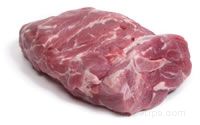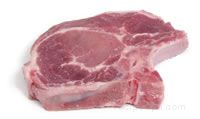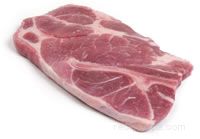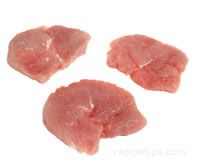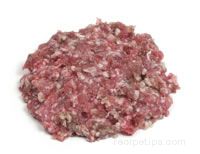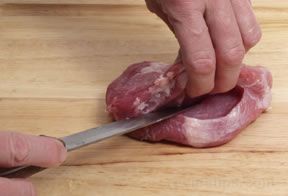|
Shopping Tips | Thawing Tips | Refrigerating Tips | Freezing Tips
Handling and Safety Tips | Marinating Tips | Stuffing Tips | Trimming & Slicing Tips
Checking Doneness | Roasting Tips | Frying Tips | Grilling & Broiling Tips
Steaming Tips | Stir-fry Tips | Tenderness Tips | Light Tips | Cooking Tips
Shopping Tips:
- Decide how much time and effort you want to use in preparing and cooking the cut you select. Chops and steaks will take less time to cook than a roast but require more attention during the cooking process.
- When feeding a large group, preparing and cooking a large roast may be less effort than trying to cook individual chops or steaks for each person. It also gives you time to attend to other dishes since the roast will need little attention while it is cooking.
- Cuts from the loin are very popular and easy to cook but are more expensive than the cuts from the shoulder, which contain more fat but are very flavorful and tender.
- Ribs are always a favorite, but will the mess created by ribs be suitable for the occasion?
- Select the right thickness of chop for the intended use. To grill, broil, braise or stuff, select chops 1 to 1 ½ inches thick, or for a quick sautéing, select chops that are no more than ½ inches thick.
- For extra speed, and convenience in cooking and serving, select boneless cuts, but be aware that you may sacrifice some flavor and juiciness due to the absence of the bones and the boneless cuts also tend to be more expensive.
- Check the label on the meat for the "sell-by" or "use by" date to be sure your selection will remain fresh until the time that you will be cooking it. If you are going to be freezing it, be sure it is frozen before its freshness expires.
- Always select pork that has been inspected and approved for wholesomeness to guarantee that the pork was processed under sanitary conditions and is free of disease.
| Note: Always select meat just before you are ready to check out at the food store. Raw meats should not be put into bags with other foods. In warm weather, raw meat should be placed inside the car so that it can be exposed to air conditioning. If the travel home will take more than an hour, be sure to have a cooler that the meat can be stored in for the ride home. |
Thawing Tips:
- Plan ahead so that you will have adequate time to defrost the frozen meat using one of the methods above. Having the meat slowly thaw in the refrigerator will result in the best quality of meat and is the safest method for preventing foodborne disease.
- When thawing in the refrigerator, realize that food placed in the coldest area of the refrigerator will take longer to thaw than if placed in another area. Also, food placed in a refrigerator set at 35°F will take longer to thaw than a refrigerator set at 40°F.
- While thawing, be sure that drippings do not contaminate other food or preparation surfaces.
- To store meat that has been thawed in the refrigerator, remove from wrapping and pat dry with a paper towel. Place on a tray with sides to catch drippings, cover loosely and place in the refrigerator in an area where there is no danger of the juices dripping onto food that will be eaten without cooking, such as raw vegetables and salad ingredients.
- When thawing meat in the refrigerator, drain the juices that accumulate on the tray holding the meat. The juices will deteriorate and spoil faster than the meat, which will then contaminate the meat.
Refrigerating Tips:
- Check the temperature of your refrigerator with an appliance thermometer on a regular basis to verify that it is maintaining the proper temperature.
- Store raw meats on the bottom shelf of the refrigerator to eliminate the chance of meat juices dripping down on other foods and contaminating them.
- Chill leftovers quickly by dividing them into shallow dishes before refrigerating. This will shorten the time that the pork is in the danger zone between 40°F and 140°F.
- If you are not sure whether the pork has been refrigerated for the maximum suggested storage time and you are questioning if it is safe to eat, do not taste test it . . . be safe and THROW IT AWAY!
Freezing Tips:
- Use moisture proof wrap or bags when freezing meat. Wax paper is not moisture proof and should not be used for wrapping pork because it will not hold the moisture in the meat.
- Be sure all packages are marked with the name of the cut and the date it was frozen.
- A double layer of wax paper can be used between chops and steaks when freezing to make them easier to separate when thawing.
- Freeze fresh pork as soon as possible to maintain the best quality.
- Store frozen meat in a freezer unit to obtain maximum storage time.
- Do not freeze canned meat. The liquid in the can may expand and cause the seal on the can to break open. Generally these items are processed to be stored in the refrigerator or are processed as shelf stable convenience items.
Handling and Safety Tips:
- Wash all work areas, utensils, and cutting boards that are exposed to raw meat and juices with hot soapy water. Periodically sanitize cutting boards with a bleaching solution consisting of one tablespoon of bleach per gallon of water.
- Wash hands with hot soapy water before and after handling pork.
- Do not use the same platter to serve cooked pork as was used when it was raw, unless it is properly cleaned first.
- Do not expose pork to unsafe temperatures (40°F to 140°F) for extended periods of time.
- Do not allow raw meat or meat juices to come in contact with other foods that will not be cooked before being consumed.
- Cook pork to approximately 145°F to 155°F to eliminate the danger of trichinosis.
Marinating Tips:
- The marinade should totally cover the meat in order for it to work effectively.
- Pork can be soaked in the marinade from a couple of hours to twelve hours or more. Be sure to store the meat in its marinade in the refrigerator during this period of time.
- Since the marinade contains an acidic ingredient, reactive containers such as metal bowls should not be used. It is best to use containers such as glass or plastic bowls or plastic bags that can be sealed.
- The marinade should not be reused for any other purpose because of the bacteria that may be present from being in contact with the raw meat. The only way the marinade can be reused is to boil it thoroughly and then use it as a basting liquid or as part of a sauce for the meat, but it is best to save some unused marinade for this purpose.
- When meat has been marinated for a long period of time it will shorten the cooking time. Twelve hour of marinating will reduce the cooking time by 30 to 35%.
Stuffing Tips:
The following guidelines should be followed in regard to stuffing:
- If using a recipe where the stuffing or any parts of it are cooked in any manner, it must be completely cooled before inserting into the meat.
- Do not overstuff because the stuffing will expand during cooking.
- Stuffing should reach an internal temperature of 165°F when eggs are one of the ingredients.
- Always thoroughly sanitize any utensils and areas exposed to the raw meat or juices.
- For stuffed chops, be sure to purchase chops that are at least 1 ¼ to 1 ½ inches thick.
| Note: NEVER stuff meat in advance. Stuffing in advance will increase the risk of bacteria growth. Stuffing can be made in advance and refrigerated separately from the meat and then inserted just before cooking. |
Tips on Trimming and Slicing:
- Be sure to use sharp knives to ensure clean cuts and to make the process easier.
- Dry meat off with a paper towel before trimming to prevent it from slipping around while cutting.
- Make a cut at one inch intervals through the fat on the edges of steaks and chops to prevent curling during cooking.
- When trying to cut thin slices, it is easier if you put the meat into the freezer for 30 minutes to an hour before slicing to help firm it up or if meat was frozen, slice before it is completely thawed.
- After cutting cubes for kabobs, butterfly each one by cutting through the center, leaving enough to hold the cube together. This will allow the cubes to absorb more of the flavor from the marinade and then be placed on the skewer as a whole cube.
Tips for Checking Doneness:
- When pricked, the juices should run clear or have just a very faint pink tint.
- Cut into the meat and check meat to see that it is white in color. When cooked to medium doneness there may be slight traces of pink in the middle.
- To ensure doneness, check with a meat thermometer. A thermometer inserted into the thickest part of the cut should produce a temperature of 145°F for medium doneness (160°F to 165°F for well done).
Tips on Roasting Pork:
- For a crisp surface on your roast, be sure the oven is fully preheated before place the roast in it and do not cover the meat while roasting.
- To add extra flavor, rub the surface of the meat with your favorite seasonings before roasting.
- Roasting at a lower oven temperature (NEVER roast meat below 200°F) will result in meat that is more flavorful and moist. It will take longer to cook but the results will be worth the wait.
- A roast with a bone in it will cook faster than a boneless roast because the bone will conduct heat faster than the meat.
- Do not use sharp utensils that may pierce the meat when trying to turn it because piercing allows valuable juices to escape. Use other utensils, such as wooden spoons and spatulas for turning the meat.
- If cooking more than one roast, be sure that there is uniform space around them so that they will cook evenly. The roasts should not be touching and there should be enough room around them to allow air and heat to circulate.
- When placing a thermometer in the meat to check for doneness, be sure that the stem of it is not touching a bone because this can result in a false reading.
- Using the drippings from the roasted meat will provide great flavor when making a stock, gravy or sauce.
Tips of Frying Pork:
- When pan-frying, the best cuts to use are boneless. Boneless cuts will lay flat on the bottom of the pan and allow the meat to cook more evenly. When the bone is left in the chop or steak, the meat around it cooks slower. Frequently, when trying to thoroughly cook the meat around the bone, the outer edges will become over done.
- Use tongs or a spatula instead of a fork when placing pieces in the pan or when turning. Piercing meat with a fork allows juices to escape.
- To help reduce splattering when frying, dry all meat with a paper towel before placing in the hot oil and if the meat has a crumb coating, let the meat stand for 20 to 30 minutes before frying. Be sure all utensils and equipment are dry before they come in contact with the oil. Water will make the oil splatter when it is heated.
- Using canola oil provides a milder taste and it contains healthier amounts of saturated and polyunsaturated fats.
- If using butter when pan-frying, mix equal portions of butter and oil to help prevent butter from burning.
- When pan-frying chops or steaks, dredging with a light coat of flour will provide a nicely browned coating on the meat and create extra brown pieces on the bottom of the pan to aid in making a flavorful sauce.
Grilling and Broiling Tips:
- Preheat grill or broiler to the proper temperature to ensure the meat surface is seared quickly to give it a flavorful crust.
- To prevent the meat from sticking, use clean racks and coat them with vegetable oil or a nonstick vegetable oil spray.
- To keep chops, steaks and ham slices flat while grilling and broiling, clip the fat and rind around the edges at 1 to 1 ½ inch intervals.
- When grilling, aromatic woods such as hickory, mesquite, apple, or cherry can be added to the preheated coals to give the meat a distinctive flavor.
- Do not use a fork to turn the pork cuts as they cook. The piercing causes juices to escape. Use tongs to turn.
- Leave an area in the charcoal grill without coals so that if a flare up occurs or some of the meat is cooking too fast, you can move the meat to this cooler area. On a gas grill, leave one burner on low.
Steaming Tips:
- Marinate cubed pork, sliced pork and ribs before steaming to give them a distinctive flavor.
- Impart flavor into the meat by adding ingredients to the steaming water, such as onions, carrots, celery, and fresh gingerroot.
- Other ingredients, such as vegetables, can be steamed with the meat but be sure to not overcrowd.
- For efficient use of time when preparing recipes that call for pork and rice, steam pork over rice as it is cooking.
- Avoid removing the cover to the pot during the cooking process. This will allow heat and steam escape, resulting in extended cooking times.
Stir-fry Tips:
- Cut ingredients into small even sized pieces. Using the same size pieces will assist in a more evenly quick cooking of all ingredients. For your convenience, you can purchase the vegetables precut for stir-frying but be prepared to pay more for it.
- To make the cutting of pork into thin strips easier, place the meat in the freezer for about ¾ to 1 hour to firm it up or if the pork was frozen, cut it into the thin strips before it is completely thawed.
- After cutting pork into thin strips, be sure to properly clean the work area. Wash cutting boards in hot soapy water after each use and use a mild bleach solution periodically.
- When adding ingredients to cook, do not add too much at one time because overcrowding will cause steaming to occur, which will prevent the food from frying properly.
- Use metal or wood utensils for stirring and tossing ingredients while cooking and avoid using plastic because it might melt when exposed to the high temperatures.
Tenderness Tips:
- Avoid freezing whenever possible to eliminate additional moisture loss during thawing, which results in less tender meat.
- Keep pork from drying out in the refrigerator by keeping it tightly wrapped. If the meat dries out it will become tough.
- Cook to the proper temperature but do not overcook or the meat will become dry and tough.
- Let meat rest for 10 to 15 minutes before carving to allow juices to be distributed throughout the flesh.
- Cutting meat across the grain will produce slices with shorter fibers, resulting in more tender pieces.
Light Tips:
- When purchasing pork, look for cuts with lower fat content, such as cuts from the loin or leg.
- Before cooking, trim visible fat to reduce fat content almost in half.
- Cook pork using a low fat cooking method, such as roasting, grilling, broiling, steaming, poaching, braising, or stewing.
- Prepare pork with herbs and spices to enhance the flavor rather than using sauces.
- To reduce the amount of fat used when frying, stir-frying, sautéing or searing pork in a pan, use a nonstick skillet which requires less added fat, or use a nonstick skillet with a fat-free nonstick cooking spray.
- If using the drippings from roasted meat to make sauces and soups, cool in the refrigerator to cause the fat to rise to the surface. The fat will solidify, making it easy to remove and discard.
- After cooking ground pork, place in a strainer and rinse under hot water to remove excess fat.
- After stewed meat is finished cooking, let cool and then chill. Once the stew is chilled the fat will rise to the top and can be easily scraped off to be discarded rather than remaining in the stew. Leaving the stew set overnight will also enhance its flavor.
Cooking Tips:
- Do not overcook pork or it will become dry and tough. The threat of trichinosis is eliminated when the pork is heated to 137°F but the USDA recommends cooking pork to 145°F to be safe. Cooking to 145°F will result in clear or slightly pink tinted juices and provides meat that is juicy and tender.
- When browning pork, drying the cut off with a paper towel before adding to the heat source will result in more even browning.
- When frying or sautéing, do not place a cover over the pan. This will lock in moisture and cause the meat to braise or steam.
- Lightly coat pork with vegetable oil to keep it from drying out during cooking.
- Before roasting pork, sear all sides to create a flavorful crust on the surface of the meat.
- Do not overcrowd pork cuts when cooking. Leaving space between them will allow them to brown and cook more evenly.
- If using a marinade for basting, set some aside before placing raw pork in it to marinate. Never reuse marinade that the meat was marinated in.
- Poach uncooked sausages for a few minutes before frying, broiling or grilling. Sausage casings should not be pierced before cooking. Piercing will cause the juices to be released and sausages will become dry.
- Do not partially cook pork and then store in refrigerator to use later. It must be cooked until done. It can be partially cooked or browned using one method, such as microwaving or searing, and then immediately cooked until done using a different method, such as roasting, frying, grilling or broiling.
|








